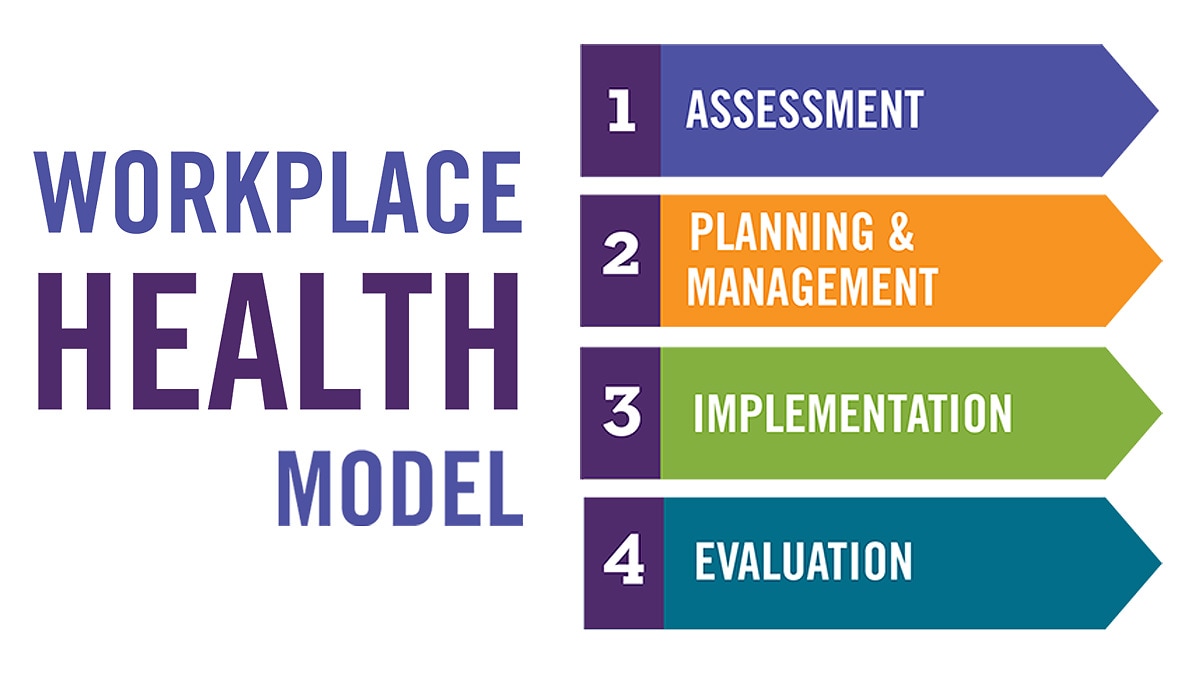At a glance
- The systematic process of building a workplace health promotion program emphasizes four main steps.
- Employers can use this four-step process and related modules to develop or improve their workplace health programs.
- The Workplace Health Program Development Checklist can be used throughout the process to review activities and monitor progress.

Step-by-step
A successful workplace health program is one that targets the specific employee population and fits the workplace, employee needs, and personal and organizational health goals. This is achieved through a workplace health assessment.
An assessment should capture the factors that influence employee health, including:
- Individual factors: Lifestyle and personal choices.
- Work environment: Physical conditions and social support.
- Organizational factors: Culture, policies, and practices.
Methods for assessment:
- Informal: Conversations, opinion boxes, or calls for input.
- Formal: Employee health survey or environmental audits.
Key considerations:
- Address both current health issues and employee interests.
- Involve employees early to reinforce the shared responsibility and commitment.
- Use the Workplace Health Resource Center to guide program priorities and improvements.
The resource center provides guidelines, tools, and resources for conducting a workplace health assessment.
Before implementing a workplace health program, careful planning is essential.
This stage involves creating a governance structure to manage health promotion activities.
- The enterprise governance structure provides the strategic direction, leadership, and organization needed to run the program.
- It ensures the program meets its goals, manages health risks, and uses resources wisely.
- It’s important to consider factors, such as the company's size, sector, and location.
Key components of the governance structure include:
- Leadership support: Senior leaders act as role models and champions.
- Health coordinator: Identify a coordinator, council, or committee to oversee the program.
- Health improvement plan: Develop a plan with resources to outline and achieve goals and strategies.
- Communication: Maintain clear and consistent communication with all employees.
- Health Informatics: Use data to plan and evaluate the program.
Tips for a successful program:
- Focus on a few well-chosen strategies rather than many poorly implemented ones.
- Consider low-cost intervention, especially for small and medium-sized companies.
- The Workplace Health Resource Center provides guidelines, tools, and resources for the planning process.
Most employers focus on individual actions to improve worker health, like losing weight, quitting smoking, and exercising. However, the environment where people work, live, and play also affects health.
Employers and employees should work together to create a healthy work environment, which makes it easier for everyone to adopt healthy habits.
- This means that workplace health programs should include both individual and organizational strategies to improve health and prevent disease.
Program strategies and interventions fall into four major categories:
- Health-related programs: Opportunities for employees to begin, change, or maintain health behaviors.
- Health-related policies: Formal or informal statements designed to protect or promote employee health. They affect large groups at the same time.
- Health benefits: Part of a compensation package, including health insurance coverage and discounts on health services.
- Environmental supports: Physical factors at or near the workplace that enhance employee health.
The Workplace Health Resource Center provides topic specific guidelines, tools, and resources for putting the program strategies in place.
Evaluating workplace health programs is crucial to understanding their effectiveness and ensuring they can be sustained over time.
Evaluation goals:
- Assess program sustainability and reception by employers and management.
- Measure return on investment (ROI).
- Identify gaps and opportunities for improvement.
Effective evaluation:
- Focus on relevant and useful questions.
- Ensure the evaluation feeds into a continuous improvement loop.
- Use findings to strengthen existing activities and describe resource efficiency.
The Workplace Health Resource Center provides guidelines, tools, and resources for assessing program efforts.
